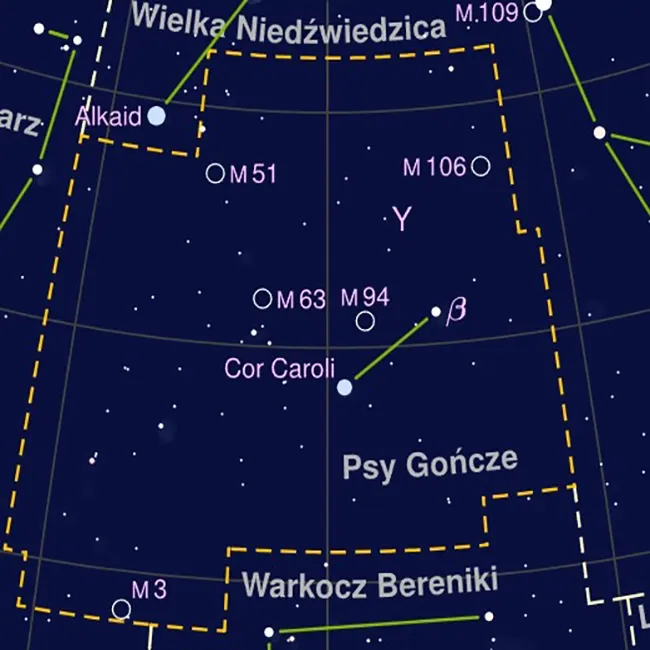
Canes Venatici is a small constellation located in the northern sky, representing the hunting dogs of the nearby constellation Boötes, the Herdsman. Though not one of the most prominent constellations, Canes Venatici is home to several interesting deep-sky objects and notable stars.
Canes Venatici is a relatively faint constellation with no stars brighter than magnitude 3. The constellation is composed mainly of two primary stars, Cor Caroli and Chara, which represent the two hunting dogs. The constellation covers an area of 465 square degrees and ranks 38th in size among the 88 modern constellations.
Key Features
The constellation's key features include:
- Cor Caroli (Alpha Canum Venaticorum): The brightest star in Canes Venatici, with a magnitude of 2.89. It is a binary star system and one of the most well-known chemically peculiar stars, showing unusual silicon, mercury, and europium lines in its spectrum.
- Chara (Beta Canum Venaticorum): The second brightest star in the constellation, with a magnitude of 4.26. Chara is a yellow-hued main-sequence star similar to our Sun.
- Messier 51 (Whirlpool Galaxy): Perhaps the most famous deep-sky object in Canes Venatici, the Whirlpool Galaxy is an interacting grand-design spiral galaxy located approximately 23 million light-years away.
- Messier 3: A globular cluster located in the constellation, one of the finest in the northern hemisphere. It is visible with binoculars and is about 33,900 light-years from Earth.
Mythology
In mythology, Canes Venatici represents the hunting dogs of Boötes, the Herdsman, who chases the Great Bear (Ursa Major) around the North Pole. The constellation was not recognized as a separate constellation until the late 17th century when it was included by the astronomer Johannes Hevelius. Before that, its stars were often associated with the neighboring constellation of Ursa Major.
Notable Stars
- Cor Caroli (Alpha Canum Venaticorum): Named after King Charles I of England, this binary star system is notable for its spectral peculiarities.
- Chara (Beta Canum Venaticorum): Meaning "joy" in Greek, Chara is a Sun-like star and is often studied as a potential solar analog.
Visibility
Canes Venatici is best observed during the spring months in the Northern Hemisphere. The constellation is visible between latitudes +90° and -40°, making it accessible to most observers worldwide.
Tips for Observing
- To locate Canes Venatici, first find the nearby, more prominent constellation of Ursa Major. The stars of Canes Venatici lie just to the south of the "handle" of the Big Dipper.
- Use binoculars or a small telescope to observe the key stars and deep-sky objects like the Whirlpool Galaxy and Messier 3.
- The constellation is relatively faint, so observing from a dark location away from city lights will improve visibility.
